Intel 4th Generation Core Processor Benchmarked
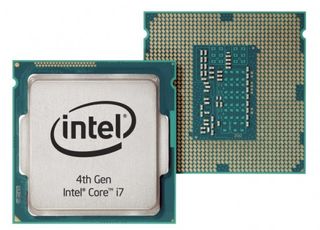
Ahead of Intel's announcement of its 4th generation Core processors (a.k.a. Haswell), we were able to get our hands on a system featuring one of the new quad core CPUs and run it through a battery of tests. So How does it compare to the previous generation?
Our system had a 2.4-GHz Intel quad-core Core i7-4700MQ processor, 32GB of RAM, dual 128GB SSDs in a RAID 2 array, and an Nvidia GeForce GTX 780M GPU with 4GB of VRAM, along with an Intel HD Graphics 4600 GPU.
Against this, we pitted the following:
- Toshiba Qosmio X875: 2.4-GHz Intel Core i7-3630QM, 16GB of RAM, 1TB 5,400-rpm hard drive, Nvidia GeForce GTX 670M
- Alienware M17x R4: 2.6GHz Intel Core i7-3720QM, 8GB of RAM, 500GB 7,200-rpm + 32GB mSATA SSD, Nvidia GeForce GTX 680M
- Alienware M18x R2: 2.7-GHz Intel Core i7-3820QM, 16GB of RAM, dual 256GB SSDs, dual Nvidia GeForce GTX 680M SLI Enabled
PCMark7
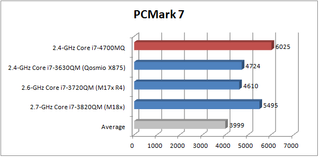
One benchmark we run on all our systems is PCMark7, which gives a general picture as to a system's performance. On this test, the Haswell chip beat out all competitors, and by a decent margin.
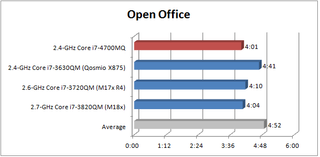
While synthetic benchmarks are well and good, how will that translate into real-world performance? We timed how long it took for the system to pair 20,000 names and addresses in OpenOffice (a shorter time is better). Here, the Haswell platform showed a modest improvement, but third-generation Intel processors weren't far behind.
Graphics Performance
Stay in the know with Laptop Mag
Get our in-depth reviews, helpful tips, great deals, and the biggest news stories delivered to your inbox.
Intel is touting that the integrated graphics in the 4th generation Core platform are twice as powerful as the previous generation. For this test, we deactivated the discrete Nvidia GPU, and relied solely on the Intel HD Graphics 4600 GPU. We then compared our results to three other systems (Samsung ATIV Book 9, the Toshiba Kirabook, and the Dell XPS 13) with the previous generation of Intel integrated graphics, as well as the Acer Aspire V5-571PG, which has a discrete Nvidia GeForce GT710M GPU, the least powerful of that company's last generation chips.
3DMark11
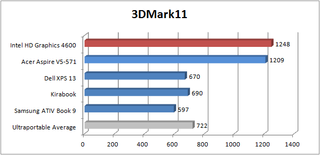
Intel's claim proved true on the synthetic benchmark 3DMark11, as the Haswell GPU nearly doubled that of the previous generation, and even edged out the Nvidia GPU.
World Of Warcraft
But how does that translate into real-world performance? To test this, we ran our "World of Warcraft" benchmark, first with the settings on autodetect, and then on Ultra. All runs were done at the notebook's native resolution of 1920 x 1080.
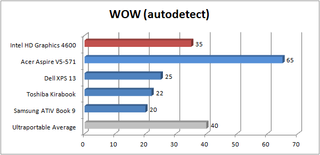
With the settings on autodetect, the Intel 4600 graphics not only outperformed the previous generation, but they also pushed the game above 30 fps, which is what we consider playable. The Acer's framerate is higher than the rest, as that system's display has a resolution of 1366 x 768, whereas all the others had 1080p panels or higher.
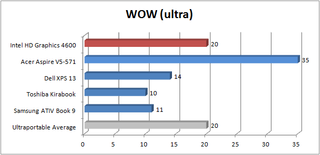
Once we cranked up all the settings, the Intel 4600 GPU was indeed twice as powerful as the previous generation, but still lacked the oomph to push the game into the playability threshold.
BioShock Infinite
Of course, "WOW" isn't the only game out there, so we decided to see how the Intel GPU would fare on BioShock Infinite. We ran this test on Low (setting 7 on the benchmarking utility) at 1366 x 768 and 1920 x 1080, and on High (setting 2) at those same resolutions.
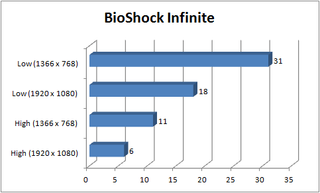
Even at the lowest settings, and with the screen at 1366 x 768, the Intel 4600 graphics barely exceeded our playability threshold of 30 fps. So, while you could play the latest titles, it ultimately wouldn't be as satisfying as using a discrete GPU.
So that's a quick look at the capabilities of Intel's 4th generation Core processors. Look for reviews of notebooks with these chips in the near future.
